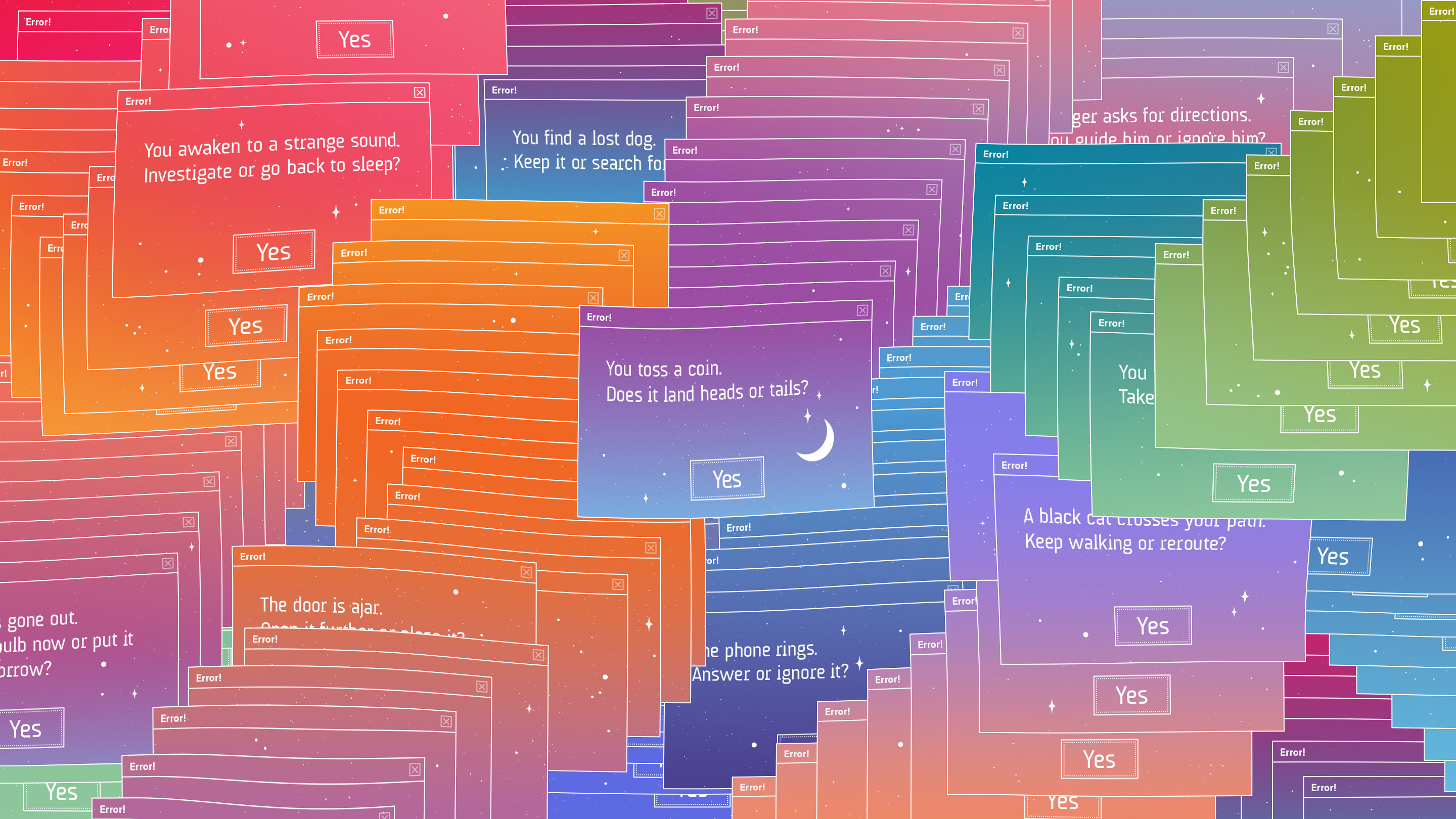Imagine a universe where every decision you've ever made, every path not taken, every "what if" scenario, actually exists in parallel realities. This isn't science fiction; it's the mind-bending realm of the many-worlds interpretation of quantum mechanics. A theory that suggests our reality is just one of countless others, branching off with every quantum event.Picture yourself standing at a crossroads, but instead of choosing one path, you take both simultaneously. In one world, you turn left; in another, you go right. This is the essence of many-worlds, where the fabric of reality splits with each quantum interaction. It challenges our understanding of existence, consciousness, and the very nature of choice. Are you ready to explore the infinite possibilities that might lie just beyond our perception? Buckle up, as we dive into the fascinating world of quantum mechanics and its mind-boggling implications for our reality.
Welcome to our fascinating journey into one of the most intriguing interpretations of quantum mechanics: the Many-Worlds Interpretation (MWI). Imagine a universe where every decision you make, every chance event, creates a branching path leading to a new, parallel universe. This isn't science fiction; it's a serious scientific hypothesis proposed by physicist Hugh Everett in 1957, suggesting an almost unimaginable reality.In this video, we dive deep into the heart of quantum mechanics to explore the foundational concepts behind the Many-Worlds Interpretation. We'll start by unraveling the mystery of quantum superposition, where particles exist in multiple states simultaneously, and the puzzle of quantum measurement, which has perplexed scientists for decades.Discover how the MWI proposes a radical solution to these quantum quandaries by suggesting that all possible outcomes of quantum measurements actually occur, each in its own newly branched universe. This interpretation eliminates the need for wavefunction collapse, offering a deterministic and symmetric view of the universe that includes both the observer and the observed.But the implications of the Many-Worlds Interpretation are as vast as they are controversial. We'll explore the mind-bending concept of parallel universes and what it means for our understanding of reality. Does every choice we make spawn a new universe? Are there infinite versions of ourselves living out alternate lives in these parallel worlds?Critics of the MWI argue that its predictions are impossible to test and that it posits an excessively extravagant view of the universe. We'll delve into these criticisms, the challenges of interpreting probabilities, and the ongoing debates within the scientific community.Join us as we navigate the complexities and marvels of the Many-Worlds Interpretation. Whether you're a seasoned physicist or just curious about the mysteries of the quantum world, this video will provide you with a deeper understanding of one of the most fascinating theories in modern physics. Prepare to have your mind expanded as we consider the profound implications of living in a multiverse.
Join renowned physicist Dr. Sean Carroll as he unravels one of science's greatest mysteries: the true nature of quantum mechanics and its mind-bending implications for reality itself.Dr. Carroll is:
- The Homewood Professor of Natural Philosophy at Johns Hopkins University Fractal Faculty at Santa Fe Institute
- Author of "The Biggest Ideas in the Universe, Vol. 2: Quanta and Fields"
- Host of the Mindscape podcast
- Recipient of prestigious awards from NSF, NASA, Royal Society of London & more
In this talk, Dr. Carroll explores:
- Why quantum mechanics remains puzzling despite its practical success
- The probabilistic nature of quantum measurements
- The revolutionary "many worlds" interpretation
- How our reality might be constantly branching into different versions
- Implications for quantum gravity and spacetime emergence
 |
| Olena Shmahalo/Quanta Magazine |
The idea that the universe splits into multiple realities with every measurement has become an increasingly popular proposed solution to the mysteries of quantum mechanics. But this “many-worlds interpretation” is incoherent, Philip Ball argues in this adapted excerpt from his new book Beyond Weird.
It is the most extraordinary, alluring and thought-provoking of all the ways in which quantum mechanics has been interpreted. In its most familiar guise, the many-worlds interpretation (MWI) suggests that we live in a near-infinity of universes, all superimposed in the same physical space but mutually isolated and evolving independently. In many of these universes there exist replicas of you and me, all but indistinguishable yet leading other lives.
The MWI illustrates just how peculiarly quantum theory forces us to think. It is an intensely controversial view. Arguments about the interpretation of quantum mechanics are noted for their passion, as disagreements that can’t be settled by objective evidence are wont to be. But when the MWI is in the picture, those passions can become so extreme that we must suspect a great deal more invested in the matter than simply the resolution of a scientific puzzle.
The MWI is qualitatively different from the other interpretations of quantum mechanics, although that’s rarely recognized or admitted. For the interpretation speaks not just to quantum mechanics itself but to what we consider knowledge and understanding to mean in science. It asks us what sort of theory, in the end, we will demand or accept as a claim to know the world.
After the Danish physicist Niels Bohr articulated and refined what became known as the Copenhagen interpretation — widely regarded as the orthodox view of quantum mechanics — in the 1930s and ’40s, it seemed that the central problem for quantum mechanics was the mysterious rupture created by observation or measurement, which was packaged up into the rubric of “collapse of the wave function.”
The wave function is a mathematical expression that defines all possible observable states of a quantum system, such as the various possible locations of a particle. Up until a measurement is made and the wave function collapses (whatever that means), there is no reason to attribute any greater a degree of reality to any of the possible states than to any other. It’s not that the quantum system is actually in one or other of these states but we don’t know which; we can confidently say that it is not in any one of these states, but is properly described by the wave function itself, which in some sense “permits” them all as observational outcomes. Where, then, do they all go, bar one, when the wave function collapses?
At first glance, the many-worlds interpretation looks like a delightfully simple answer to that mysterious vanishing act. It says that none of the states vanishes at all, except to our perception. It says, in essence, let’s just do away with wave function collapse altogether.
This solution was proposed by the young physicist Hugh Everett III in his 1957 doctoral thesis at Princeton, where he was supervised by John Wheeler. It purported to solve the “measurement problem” using only what we know already: that quantum mechanics works.
But Bohr and colleagues didn’t bring wave function collapse into the picture just to make things difficult. They did it because that’s what seems to happen. When we make a measurement, we really do get just one result out of the many that quantum mechanics offers. Wave function collapse seemed to be demanded in order to connect quantum theory to reality.
So what Everett was saying was that it’s our concept of reality that’s at fault. We only think that there’s a single outcome of a measurement. But in fact all of them occur. We only see one of those realities, but the others have a separate physical existence too.
 |
| The American physicist Hugh Everett III, who proposed the many-worlds interpretation of quantum mechanics in his doctoral thesis at Princeton University in 1957. - Wikipedia |
In effect, this implies that the entire universe is described by a gigantic wave function that contains within it all possible realities. This “universal wave function,” as Everett called it in his thesis, begins as a combination, or superposition, of all possible states of its constituent particles. As it evolves, some of these superpositions break down, making certain realities distinct and isolated from one another. In this sense, worlds are not exactly “created” by measurements; they are just separated. This is why we shouldn’t, strictly speaking, talk of the “splitting” of worlds (even though Everett did), as though two have been produced from one. Rather, we should speak of the unraveling of two realities that were previously just possible futures of a single reality.
(The many-worlds interpretation is distinct from the multiverse hypothesis, which envisions other universes, born in separate Big Bangs, that have always been physically disconnected from our own.)
When Everett presented his thesis, and at the same time published the idea in a respected physics journal, it was largely ignored. It wasn't until 1970 that people began to take notice, after an exposition on the idea was presented in the widely read magazine Physics Today by the American physicist Bryce DeWitt.
This scrutiny forced the question that Everett’s thesis had somewhat skated over. If all the possible outcomes of a quantum measurement have a real existence, where are they, and why do we see (or think we see) only one? This is where the many worlds come in. DeWitt argued that the alternative outcomes of the measurement must exist in a parallel reality: another world. You measure the path of an electron, and in this world it seems to go this way, but in another world it went that way.
That requires a parallel, identical apparatus for the electron to traverse. More, it requires a parallel you to observe it — for only through the act of measurement does the superposition of states seem to “collapse.” Once begun, this process of duplication seems to have no end: you have to erect an entire parallel universe around that one electron, identical in all respects except where the electron went. You avoid the complication of wave function collapse, but at the expense of making another universe. The theory doesn’t exactly predict the other universe in the way that scientific theories usually make predictions. It’s just a deduction from the hypothesis that the other electron path is real too.
This picture gets really extravagant when you appreciate what a measurement is. In one view, any interaction between one quantum entity and another — a photon of light bouncing off an atom — can produce alternative outcomes, and so demands parallel universes. As DeWitt put it, “Every quantum transition taking place on every star, in every galaxy, in every remote corner of the universe is splitting our local world on earth into myriads of copies.” In this “multiverse,” says the physicist and many-worlds proponent Max Tegmark, “all possible states exist at every instant” — meaning, at least in the popular view, that everything that is physically possible is (or will be) realized in one of the parallel universes.
In particular, after a measurement takes place, there are two (or more) versions of the observer where before there was one. “The act of making a decision,” says Tegmark — a decision here counting as a measurement, generating a particular outcome from the various possibilities — “causes a person to split into multiple copies.” Both copies are in some sense versions of the initial observer, and both of them experience a unique, smoothly changing reality that they are convinced is the “real world.” At first these observers are identical in all respects except that one observed this path of the electron (or whatever is being measured) and the other that path. But after that, who can say? Their universes go their separate ways, launched on a trajectory of continual unraveling.
You can probably see why the MWI is the interpretation of quantum mechanics that wins all the glamour and publicity. It tells us that we have multiple selves, living other lives in other universes, quite possibly doing all the things that we dream of but will never achieve (or never dare to attempt). There is no path not taken. For every tragedy, like Gwyneth Paltrow’s character being hit by a van in the many-worlds-inspired 1998 movie Sliding Doors, there is salvation and triumph.
Who could resist that idea?
There are, of course, some questions to be asked. For starters, about this business of bifurcating worlds. How does a split actually happen?
That is now seen to hinge on the issue of how a microscopic quantum event gives rise to macroscopic, classical behavior through a process called “decoherence,” in which the wavelike states of a quantum system become uncoordinated and scrambled by their interactions with their environment. Parallel quantum worlds have split once they have decohered, for by definition decohered wave functions can have no direct, causal influence on one another. For this reason, the theory of decoherence developed in the 1970s and ’80s helped to revitalize the MWI by supplying a clear rationale for what previously seemed a rather vague contingency.
In this view, splitting is not an abrupt event. It evolves through decoherence and is only complete when decoherence has removed all possibility of interference between universes. While it’s popular to regard the appearance of distinct worlds as akin to the bifurcation of futures in Jorge Luis Borges’ story “The Garden of Forking Paths,” a better analogy might therefore be something like the gradual separation of shaken salad dressing into layers of oil and vinegar. It’s then meaningless to ask how many worlds there are — as the philosopher of physics David Wallace aptly puts it, the question is rather like asking, “How many experiences did you have yesterday?” You can identify some of them, but you can’t enumerate them.
What we can say a little more precisely is what kind of phenomenon causes splitting. In short, it must happen with dizzying profusion. Just within our own bodies, there must be at least as many splitting events affecting each of us every second as there are encounters between our molecules in the same space of time. Those numbers are astronomical.
The main scientific attraction of the MWI is that it requires no changes or additions to the standard mathematical representation of quantum mechanics. There is no mysterious, ad hoc and abrupt collapse of the wave function. And virtually by definition it predicts experimental outcomes that are fully consistent with what we observe.
But if we take what it says seriously, it soon becomes clear that the conceptual and metaphysical problems with quantum mechanics aren’t banished by virtue of this apparent parsimony of assumptions and consistency of predictions. Far from it.
The MWI is surely the most polarizing of interpretations. Some physicists consider it almost self-evidently absurd; “Everettians,” meanwhile, are often unshakable in their conviction that this is the most logical, consistent way to think about quantum mechanics. Some of them insist that it is the only plausible interpretation — for the arch-Everettian David Deutsch, it is not in fact an “interpretation” of quantum theory at all, any more than dinosaurs are an “interpretation” of the fossil record. It is simply what quantum mechanics is. “The only astonishing thing is that that’s still controversial,” Deutsch says.
My own view is that the problems with the MWI are overwhelming — not because they show it must be wrong, but because they render it incoherent. It simply cannot be articulated meaningfully.
I’ll attempt to summarize the problems, but first, let’s dispense with a wrong objection. Some criticize the MWI on aesthetic grounds: People object to all those countless other universes, multiplying by the trillion every nanosecond, because it just doesn’t seem proper. Other copies of me? Other world histories? Worlds where I never existed? Honestly, whatever next! This objection is rightly dismissed by saying that an affront to one’s sense of propriety is no grounds for rejecting a theory. Who are we to say how the world should behave?
A stronger objection to the proliferation of worlds is not so much all this extra stuff you’re making, but the insouciance with which it is made. Roland Omnès says the idea that every little quantum “measurement” spawns a world “gives an undue importance to the little differences generated by quantum events, as if each of them were vital to the universe.” This, he says, is contrary to what we generally learn from physics: that most of the fine details make no difference at all to what happens at larger scales.
But one of the most serious difficulties with the MWI is what it does to the notion of self. What can it mean to say that splittings generate copies of me? In what sense are those other copies “me?”
Brian Greene, a well-known physics popularizer with Everettian inclinations, insists simply that “each copy is you.” You just need to broaden your mind beyond your parochial idea of what “you” means. Each of these individuals has its own consciousness, and so each believes he or she is “you” — but the real “you” is their sum total.
There’s an enticing frisson to this idea. But in fact the very familiarity of the centuries-old doppelgänger trope prepares us to accept it rather casually, and as a result the level of the discourse about our alleged replica selves is often shockingly shallow — as if all we need contemplate is something like teleportation gone awry in an episode of “Star Trek.” We are not being astonished but, rather, flattered by these images. They sound transgressively exciting while being easily recognizable as plotlines from novels and movies.
Tegmark waxes lyrical about his copies: “I feel a strong kinship with parallel Maxes, even though I never get to meet them. They share my values, my feelings, my memories — they’re closer to me than brothers.” But this romantic picture has, in truth, rather little to do with the realities of the MWI. The “quantum brothers” are an infinitesimally small sample cherry-picked for congruence with our popular fantasies. What about all those “copies” differing in details graduating from the trivial to the utterly transformative?
The physicist Lev Vaidman has thought rather carefully about this matter of quantum youness. “At the present moment there are many different ‘Levs’ in different worlds,” he says, “but it is meaningless to say that now there is another ‘I.’ There are, in other words, beings identical to me (at the time of splitting) in these other worlds, and all of us came from the same source — which is ‘me’ right now.”
The “I” at each moment of time, he says, is defined by a complete classical description of the state of his body and brain. But such an “I” could never be conscious of its existence.
Consciousness relies on experience, and experience is not an instantaneous property: It takes time, not least because the brain’s neurons themselves take a few milliseconds to fire. You can’t “locate” consciousness in a universe that is frantically splitting countless times every nanosecond, any more than you can fit a summer into a day.
One might reply that this doesn’t matter, so long as there’s a perception of continuity threading through all those splittings. But in what can that perception reside, if not in a conscious entity?
And if consciousness — or mind, call it what you will — were somehow able to snake along just one path in the quantum multiverse, then we’d have to regard it as some nonphysical entity immune to the laws of (quantum) physics. For how can it do that when nothing else does?
David Wallace, one of the most ingenious Everettians, has argued that purely in linguistic terms the notion of “I” can make sense only if identity/consciousness/mind is confined to a single branch of the quantum multiverse. Since it is not clear how that can possibly happen, Wallace might then have inadvertently demonstrated that the MWI is not after all proposing a conceit of “multiple selves.” On the contrary, it is dismantling the whole notion of selfhood. It is denying any real meaning of “you.”
I shouldn’t wish anyone to think that I feel affronted by this. But if the MWI sacrifices the possibility of thinking meaningfully about selfhood, we should at least acknowledge that this is so, and not paper over it with images of “quantum brothers and sisters.”
The science-fiction vision of a “duplicated quantum self” has nevertheless delivered some fanciful, and undeniably entertaining, images. If splitting can be guaranteed by any experiment in which the outcome of a quantum process is measured, then one can imagine making a “quantum splitter”: a handheld device that measures, say, an electron’s intrinsic quantum angular momentum, or spin, which can be thought of as having two states, either pointing up or down; it then converts the result to a macroscopic arrow pointing on a dial to “Up” or “Down.” This conversion ensures that the initial superposition of spin states is fully decohered into a classical outcome. You can make these measurements as often as you like just by pushing the button on the device. Each time you do (so the story goes), two distinct “yous” come into being.
What can you do with this power to generate worlds and selves? You could become a billionaire by playing quantum Russian roulette. Your quantum splitter is activated while you sleep, and if the dial says Up then you’re given a billion dollars when you wake. If it shows Down then you are put to death painlessly in your sleep. Few people, I think, would accept these odds on a coin toss. But a committed Everettian should have no hesitation about doing so using the quantum splitter. For you can be certain, in this view, that you’ll wake up to be presented with the cash. Of course, only one of “you” wakes up at all; the others have been killed. But those other yous knew nothing of their demise. Sure, you might worry about the grief afflicted on family and friends in those other worlds. But that aside, the rational choice is to play the game. What could possibly go wrong?
You’re not going to play? OK, I see why. You’re worried about the fact that you’re going to die as a result, with absolute certainty. But look, you’re going to live and become rich with absolute certainty too.
Are you having trouble comprehending what that means? Of course you are. It has no meaning in any normal sense of the word. The claim is, in words aptly coined by the physicist Sean Carroll in another context (ironically, Carroll is one of the most vocal Everettians), “cognitively unstable.”
Some Everettians have tried to articulate a meaning nonetheless. They argue that, despite the certainty of all outcomes, it is rational for any observer to consider the subjective probability for a particular outcome to be proportional to the amplitude of that world’s wave function — or what Vaidman calls the “measure of existence” of that world.
It’s a misleading term, since there’s no sense in which any of the many worlds exists less. For the “self” that ends up in any given world, that’s all there is — for better or worse. Still, Vaidman insists that we ought rationally to “care” about a post-splitting world in proportion to this measure of existence. On this basis, he feels that playing quantum Russian roulette again and again (or even once, if there’s a very low measure of existence for the “good” outcome) should be seen as a bad idea, regardless of the morality, “because the measure of existence of worlds with Lev dead will be much larger than the measure of existence of the worlds with a rich and alive Lev.”
What this boils down to is the interpretation of probabilities in the MWI. If all outcomes occur with 100-percent probability, where does that leave the probabilistic character of quantum mechanics? And how can two (or for that matter, a thousand) mutually exclusive outcomes all have 100-percent probability?
There is a huge and unresolved literature on this question, and some researchers see it as the issue on which the idea stands or falls. But much of the discussion assumes, I think wrongly, that the matter is independent of questions about the notion of selfhood.
Attempts to explain the appearance of probability within the MWI come down to saying that quantum probabilities are just what quantum mechanics looks like when consciousness is restricted to only one world. As we saw, there is in fact no meaningful way to explain or justify such a restriction. But let’s accept for now — just to see where it leads — the popular view of the MWI that two copies of an observer emerge from the one who exists before a measurement, and that both copies experience themselves as unique.
Imagine that our observer, Alice, is playing a quantum version of a simple coin-toss gambling game — nothing as drastic or emotive as quantum Russian roulette — that hinges on measurement of the spin state of an atom prepared in a 50:50 superposition of up and down. If the measurement elicits up, she doubles her money. If it’s down, she loses it all.
If the MWI is correct, the game seems pointless — for Alice will, with certainty, both win and lose. And there’s no point her saying, “Yes, but which world will I end up in?” Both of the two Alices that exist once the measurement is made are in some sense present in the “her” before the toss.
 |
| Philip Ball, author of Beyond Weird: Why Everything You Thought You Knew About Quantum Physics Is Different. | Richard Haughton |
But now let’s do the sleeping trick. Alice is put to sleep before the measurement is made, knowing she will be wheeled into one of two identical rooms depending on the outcome. Both rooms contain a chest. Inside one is twice her stake, while the other is empty. When she wakes, she has no way of telling, without opening the chest, whether it contains the winning money. But she can then meaningfully say that there is a 50-percent probability that it does. What’s more, she can say before the experiment that, when she awakes, these will be the odds deduced by her awakened self as she contemplates the still-closed chest. Isn’t that a meaningful concept of probability?
The notion here is that quantum events that occur for certain in the MWI can still elicit probabilistic beliefs in observers simply because of their ignorance of which branch they are on.
But it won’t work. Suppose Alice says, with scrupulous care, “The experience I will have is that I will wake up in a room containing a chest that has a 50-percent chance of being filled or empty.” The Everettian would say Alice’s statement is correct: It’s a rational belief.
But what if Alice were to say, “The experience I will have is that I will wake up in a room containing a chest that has a 100-percent chance of being empty”? The Everettian must accept this statement as a true and rational belief too, for the initial “I” here must apply to both Alices in the future.
In other words, Alice Before can’t use quantum mechanics to predict what will happen to her in a way that can be articulated — because there is no logical way to talk about “her” at any moment except the conscious present (which, in a frantically splitting universe, doesn’t exist). Because it is logically impossible to connect the perceptions of Alice Before to Alice After, “Alice” has disappeared. You can’t invoke an “observer” to make your argument when you have denied pronouns any continuity.
What the MWI really denies is the existence of facts at all. It replaces them with an experience of pseudo-facts (we think that this happened, even though that happened too). In so doing, it eliminates any coherent notion of what we can experience, or have experienced, or are experiencing right now. We might reasonably wonder if there is any value — any meaning — in what remains, and whether the sacrifice has been worth it.
Every scientific theory (at least, I cannot think of an exception) is a formulation for explaining why things in the world are the way we perceive them to be. This assumption that a theory must recover our perceived reality is generally so obvious that it is unspoken. The theories of evolution or plate tectonics don’t have to include some element that says “you are here, observing this stuff”; we can take that for granted.
But the MWI refuses to grant it. Sure, it claims to explain why it looks as though “you” are here observing that the electron spin is up, not down. But actually it is not returning us to this fundamental ground truth at all. Properly conceived, it is saying that there are neither facts nor a you who observes them.
It says that our unique experience as individuals is not simply a bit imperfect, a bit unreliable and fuzzy, but is a complete illusion. If we really pursue that idea, rather than pretending that it gives us quantum siblings, we find ourselves unable to say anything about anything that can be considered a meaningful truth. We are not just suspended in language; we have denied language any agency. The MWI — if taken seriously — is unthinkable.
Its implications undermine a scientific description of the world far more seriously than do those of any of its rivals. The MWI tells you not to trust empiricism at all: Rather than imposing the observer on the scene, it destroys any credible account of what an observer can possibly be. Some Everettians insist that this is not a problem and that you should not be troubled by it. Perhaps you are not, but I am.
Yet I have pushed hard against the MWI not so much to try to demolish it as to show how its flaws, once brought to light, are instructive. Like the Copenhagen interpretation (which also has profound problems), it should be valued for forcing us to confront some tough philosophical questions.
What quantum theory seems to insist is that at the fundamental level the world cannot supply clear “yes/no” empirical answers to all the questions that seem at face value as though they should have one. The calm acceptance of that fact by the Copenhagen interpretation seems to some, and with good reason, to be far too unsatisfactory and complacent. The MWI is an exuberant attempt to rescue the “yes/no” by admitting both of them at once. But in the end, if you say everything is true, you have said nothing.
We needn’t fear a scientific idea that changes our view of macroscopic reality. But an idea that, when we pursue it seriously, makes that view inchoate and unspeakable doesn’t fulfill the function of science. The value of the many worlds, then, is that they close off an easy way out. It was worth admitting them in order to discover that they are a dead end. But there is no point then sitting there insisting we have found the way out. We need to go back and keep searching.






